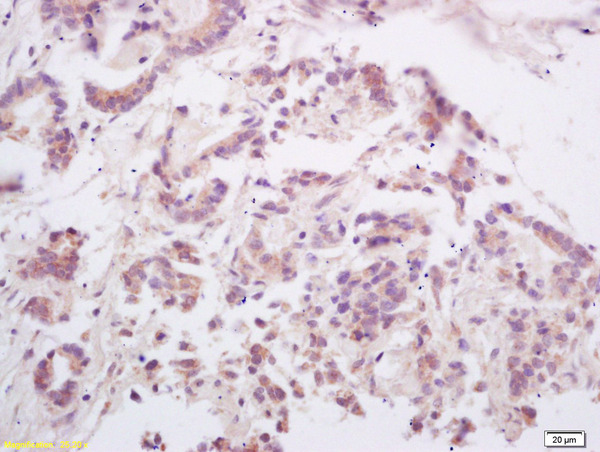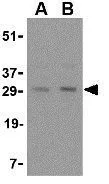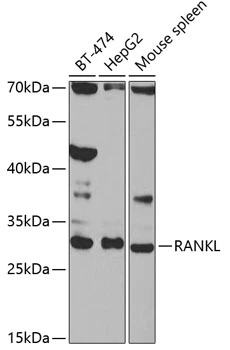RANKL antibody [5F12]
GTX53036
ApplicationsWestern Blot, ImmunoHistoChemistry, ImmunoHistoChemistry Paraffin, Neutralisation/Blocking
Product group Antibodies
TargetTNFSF11
Overview
- SupplierGeneTex
- Product NameRANKL antibody [5F12]
- Delivery Days Customer9
- Application Supplier NoteWB: 1:500 - 1:1000. IHC-P: 1:20 - 1:100. *Optimal dilutions/concentrations should be determined by the researcher.Not tested in other applications.
- ApplicationsWestern Blot, ImmunoHistoChemistry, ImmunoHistoChemistry Paraffin, Neutralisation/Blocking
- CertificationResearch Use Only
- ClonalityMonoclonal
- Clone ID5F12
- Concentration500 ug/ml
- ConjugateUnconjugated
- Gene ID8600
- Target nameTNFSF11
- Target descriptionTNF superfamily member 11
- Target synonymsCD254, ODF, OPGL, OPTB2, RANKL, TNLG6B, TRANCE, hRANKL2, sOdf, tumor necrosis factor ligand superfamily member 11, TNF-related activation-induced cytokine, osteoclast differentiation factor, osteoprotegerin ligand, receptor activator of nuclear factor kappa B ligand, tumor necrosis factor (ligand) superfamily, member 11, tumor necrosis factor ligand 6B, tumor necrosis factor superfamily member 11
- HostMouse
- IsotypeIgG2
- Protein IDO14788
- Protein NameTumor necrosis factor ligand superfamily member 11
- Scientific DescriptionThis gene encodes a member of the tumor necrosis factor (TNF) cytokine family which is a ligand for osteoprotegerin and functions as a key factor for osteoclast differentiation and activation. This protein was shown to be a dentritic cell survival factor and is involved in the regulation of T cell-dependent immune response. T cell activation was reported to induce expression of this gene and lead to an increase of osteoclastogenesis and bone loss. This protein was shown to activate antiapoptotic kinase AKT/PKB through a signaling complex involving SRC kinase and tumor necrosis factor receptor-associated factor (TRAF) 6, which indicated this protein may have a role in the regulation of cell apoptosis. Targeted disruption of the related gene in mice led to severe osteopetrosis and a lack of osteoclasts. The deficient mice exhibited defects in early differentiation of T and B lymphocytes, and failed to form lobulo-alveolar mammary structures during pregnancy. Two alternatively spliced transcript variants have been found. [provided by RefSeq, Jul 2008]
- Storage Instruction-20°C or -80°C,2°C to 8°C
- UNSPSC12352203







![IHC-P analysis of human tonsil tissue using GTX12125 sRANKL antibody [12A380]. Dilution : 1:50 Antigen retrieval : Heat induced antigen retrieval (HIER) using 10mM sodium citrate buffer (pH 6.0)](https://www.genetex.com/upload/website/prouct_img/normal/GTX12125/GTX12125_387_IHC-P_w_23060519_700.webp)
